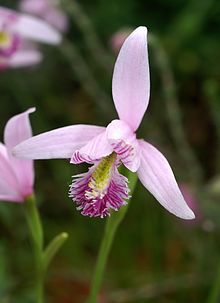Pogonia ophioglossoides, the snakemouth orchid[2] or rose pogonia, is a species of orchid occurring from central Canada to the east-central and eastern United States. It is the type species of the genus Pogonia. It is pollinated by bees.[3] This species occurs in wet habitats. In the north, the habitat is typically fens[4] but sometimes also bogs. Further south, along the Gulf Coast, it is a species of wet pine savannas and flatwoods.[5]
| Pogonia ophioglossoides | |
|---|---|

| |
| Flower of Pogonia ophioglossoides | |
| Scientific classification | |
| Kingdom: | Plantae |
| Clade: | Tracheophytes |
| Clade: | Angiosperms |
| Clade: | Monocots |
| Order: | Asparagales |
| Family: | Orchidaceae |
| Subfamily: | Vanilloideae |
| Genus: | Pogonia |
| Species: | P. ophioglossoides
|
| Binomial name | |
| Pogonia ophioglossoides | |
| Synonyms | |
References
editWikimedia Commons has media related to Pogonia ophioglossoides.
Wikispecies has information related to Pogonia ophioglossoides.
- ^ Maiz-Tome, L. (2017). "Pogonia ophioglossoides". IUCN Red List of Threatened Species. 2017: e.T64321383A67730457. doi:10.2305/IUCN.UK.2017-2.RLTS.T64321383A67730457.en. Retrieved 22 August 2023.
- ^ USDA, NRCS (n.d.). "Pogonia ophioglossoides". The PLANTS Database (plants.usda.gov). Greensboro, North Carolina: National Plant Data Team. Retrieved 9 October 2015.
- ^ Liggio, J. and Liggio, A.O. 1999. Wild Orchids of Texas. University of Texas Press, Austin. p.149
- ^ Reddoch, J. and Reddoch, A. (1997). The Orchids in the Ottawa district. Canadian Field-Naturalist, 111, 1–185.
- ^ Liggio, J. and Liggio, A.O. 1999. Wild Orchids of Texas. University of Texas Press, Austin. p.149
